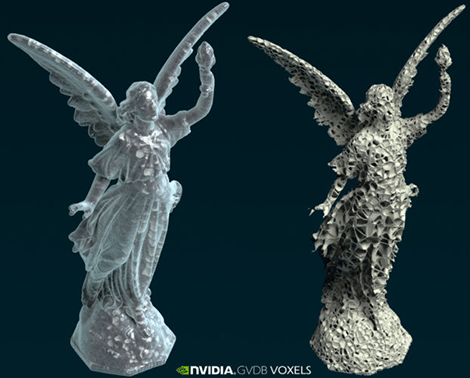
GVDB Voxels printed a 3D statue (L) of a complex image (R) with structural support and minimal material
As 3D printing charges towards its goal of complex multi-material, coloured, differing density prints, some limitations kick in – namely automation of designs for best possible prints.
HP Labs and Nvidia have now described how they’ve worked together to overcome these challenges using Nvidia’s new GVDB Voxel open source software development kit.
With a goal of 3D printing a winged angel statue, the test project amounted to adjusting the density of materials to account for external forces that increased structural integrity where needed, while minimising the amount and weight of material needed to produce it.
“Iteration can happen during infilling, or while analysing and determining stress,” said Rama Hoetzlein, the lead architect for GVDB Voxels.
Hoetzlein added that the SDK is designed for simple efficient computation, simulation and rendering, even when there’s sparse volumetric data.
It includes a compute API that generates high-resolution data and requires minimal memory footprint, and a rendering API that supports development of CUDA and NVIDIA OptiX pathways, allowing users to write custom rendering kernels.
The researchers’ effort started with a polygonal statue, which was subject to a stress simulation before the GVDB Voxels took over.
The object is converted into a model made of small voxel cubes before the software optimises the in-filling structure, varying the density based on the results of the stress simulation.
Nvidia states that the GVDB Voxels SDK has eased the complexity of 3D printing workflows by offering a platform for large-scale voxel simulation and high-quality ray-traced visualisations, while allowing for continuous data manipulation throughout the process.
By combining GVDB Voxels with the latest Nvidia Pascal architecture GPUs generated results 50 per cent faster than the previous generation of GPUs, and up to 10x faster than CPU techniques.
The SDK makes this possible by storing data only at the surface of the object. That reduces memory requirements without sacrificing resolution.






